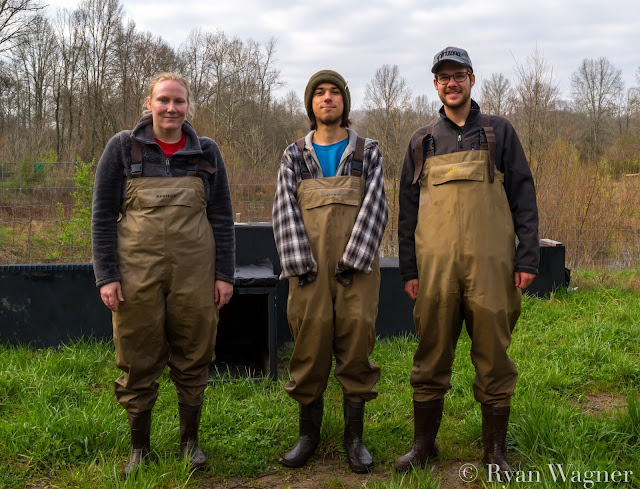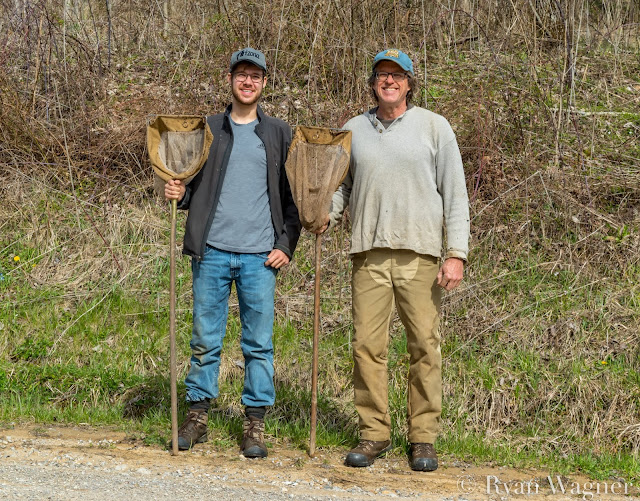The more I learn about the world of reptiles and amphibians, the more baffled I become. Many would dismiss these slimy and scaly creatures of the mud and earth as dull or disinteresting, but herps (the less than glamorous term used to describe them) never fail to surprise me. The secretive nature of herps conceals much of their life history from would-be observers, making them more challenging to apprehend than our fellow, quick-paced mammals or melodious and vibrant birds. But herps conceal a charm and an allure known all too well by those who seek them. This drive, to encounter wild creatures on their own terms, is shared by all who wish to grasp the true nature of wildlife. Observing an organism first hand provides an insight that can’t be found through any book or website. Kneeling down to their level changes your perspective. It’s the ectotherms that make the world go round.
 |
| My study for finals when you can catch snapping turtles on campus? |
The personal lives of reptiles and amphibians take place on a smaller scale compared to those of birds or mammals. Most are relatively slow and sedentary, others are capable of only short burst of speed, lacking the endurance to travel beyond their limited home range. While its possible (with great luck and skill) to see just about every migrating warbler species in the span of a few days to weeks in one location (Magee Marsh comes to mind), there is nowhere in Ohio where you could see every salamander species occurring together. Herps tend to exclude or replace one another across their range, especially when closely related species are involved. You might find eastern milksnakes in one township, but switch to eastern black kingsnakes just a few miles into the next. This creates a patchwork of native species, some overlapping, others with ill-defined, but very real boundaries.
Herps are intimately tied to their environment in a way endotherms are not. They depend not only on a suitable temperature range, but also on the proper topography, soil type, and moisture levels. If you know the right habitat for your species of interest, then your odds of discovery are greatly improved. This is one of those things, however, that sounds better on paper than in practice. For reasons that allude most herpers, some species have never been documented in habitats that seem perfectly suitable for them. Others pop up in places where you would never start your search. It is often said that herp range maps better reflect the distribution of herpetologists rather than the animals themselves.
To observe a certain species, one must thoroughly explore the habitat in which a population can [potentially] be found. I can think of no better example for the proverbial needle in a hay stack. Some species can be discovered with just a little luck and persistence. If enough time is spent hiking through the woods, a garter snake or a painted turtle will eventually offer a glimpse of their presence. A timber rattlesnake, on the other hand, is not so easily discovered. The rugged, rocky, and densely forested landscapes that these snakes haunt are challenge enough to explore. The low abundance of this species (from years of human persecution), their secretive nature, and their camouflage, make timber rattlers one the the hardest herps to discover in Ohio.
The trouble with herping is that it’s not a localized activity. It’s a scavenger hunt spread throughout the state without the convenience of eBird or a community that readily shares locations and sightings (usually for the safety of vulnerable populations). The time it would take to locate the nearly 80 species of herps in Ohio by yourself would be staggering. To have success with even a single species, you need a well thought out plan, familiarity with the area, and an intimate knowledge of the creature for which you are searching. Or even better: someone else who knows where to look and a little dumb luck.
This is where science can really help out an aspiring wildlife student. Getting involved with undergraduate research has provided me with incredible opportunities and introduced me to species I'd never dreamed of finding. I've been able to trap, measure, weigh and toe clip (yes indeed) everything from turtles to frogs, newts, and salamanders. I've accompanied graduate students out tracking timber rattlesnakes and am currently working as a lead tracker on a box turtle study.
I’ve become somewhat known as the self-proclaimed herper who just can’t find a black ratsnake (somehow, this topic always works its way into my conversations). I sometimes feel like I go around saying, “Hi! I’m Ryan Wagner and I’ve never seen a ratsnake (and obviously really really want to),” only to hear about a snake that the listener saw just days earlier (herper or not). Ratsnakes represent everything I love and hope to achieve in the pursuit of reptiles and amphibians. They are our longest native snake, are usually docile when encountered, are down right common, and yet, despite a lifetime of searching, I had never seen so much as a shed skin. I’ve written about my ratsnake nemesis HERE. Last month, thanks to the community of biologists I've come to know, I finally found my ratsnake.
This is where science can really help out an aspiring wildlife student. Getting involved with undergraduate research has provided me with incredible opportunities and introduced me to species I'd never dreamed of finding. I've been able to trap, measure, weigh and toe clip (yes indeed) everything from turtles to frogs, newts, and salamanders. I've accompanied graduate students out tracking timber rattlesnakes and am currently working as a lead tracker on a box turtle study.
 |
| The swamp team in our very fashionable waders. |
It was during a Bioblitz at The Ridges, the system of nature trails just beyond campus, where my fateful encounter finally took place. Grad student Charlene Hopkins had orchestrated a survey of the land lab to document the various species that occur there. I knew one of the teams was bound to find a ratsnake. If you've never heard of a Bioblitz before (I know I hadn't) it works like this: A team leader, armed with clipboard and data sheet, and a small group of undergrads, attempt to record every species they can find in an acre plot. No insect, wildflower, bird call, salamander, or lichen goes untallied. It's really a fantastic time and great opportunity to show of your newly developed plant identification skills (wink, wink).
My team did not find the ratsnake, but the team next to us did. "Don't you still need a rat," one of the grad students called to me. Of course I did. On our hike over to see if the snake could be refound, my friend and fellow turtle tracker Eva Gracia asked, "What are you going to do if we find it? That's like, your whole persona." I had to admit, I was a little nervous. After a few minutes of searching, it seemed the snake had alluded me once again, but then, someone shouted that they had found it slinking away across the trail. Stupefied, I picked the snake up. As one of my lab mates hiked up to our huddled group, he exclaimed, "Ryan! Ryaaan!" just as shocked about the species of serpent I was holding as I was. Since then, the floodgates have opened and I have found two more black ratsnakes.
 |
| Me and my rat snake at long last. |
I would like to believe that my lack of success with some species hasn't been due to lack of effort. I used to joke about “out-herping” everyone I had ever been in the field with. That is, until I met Carl Brune. When out hiking, I am always itching to flip “just one more rock,” inadvertently adding another hour and a half to the journey. Many of my past herping companions have sworn to “never again” accompany me on one of my adventures. I used to find this funny and chock it up to lack of interest or commitment on their part. Call it passion or sheer stubbornness, I can't help but imagine what might lie beyond the next bend. If there is the potential to find something new and fascinating, then why not flip just one more rock? How foolish I was.
Carl started bringing me along on his herping expeditions late last August. I quickly learned that a trip into the field with Dr. Brune constitutes a full day endeavor. On Sunday mornings (around 8 am), Carl would swing by the OU campus to pick me up. I’d usually be standing awkwardly in front of Clippinger Laboratories, dawned in full field gear, backpack, and with snake hook in hand. Fellow students would spare me puzzled glances as they walked past. I just grinned back—snakes and salamanders the only thing on my mind. The day's trek could hold anything.
Carl is truly the kind of herper that has forgotten more about reptiles and amphibians than most will ever know. He is always glad to share his thoughts on my endless herp-related questions. Carl is a treasure trove of knowledge; if he doesn't know the answer, there are likely few out there who do. He has explored just about every back country road and woodland strip in southern Ohio with enough space to park a truck along.
I sometimes wonder what other hikers must think when they come upon the tell-tail signs of a Brune. Evenly spaced wooden boards and neatly folded carpets hauled out of reach of most trash pickers and placed along the edge between tree line and field must be a puzzling sight for the non-herp oriented hiker. Cover objects, like these, draw in reptiles and some amphibians, making their discovery more reliable. Flipped board by flipped board, Carl has picked apart the secrets of southern Ohio’s herpetofauna. He knows these creatures and their habitats more intimately than anyone I have ever met.
Even with his years of experience, Carl admits that many aspect of herps still baffle him. “I don’t pretend to understand it, but…” he often begins when answering my barrage of questions. The complex relationships between different species distributions, where each occurs and why, is something that no one fully understands. The main goal behind Carl’s herping trips (besides just catching and photographing cool critters) is to further the knowledge and understanding of Ohio’s southern herps. He has helped to expand the known ranges of species from copperheads to streamside salamanders. Carl has even authored several chapters in the immense Amphibians of Ohio textbook (American toad, Fowler's toad, and mud salamander). It is a privilege to herp alongside him.
On the truly long days (which can push 12 hours in near 90 degree heat), I try to keep my legs going if not my brain. My endless questions eventually lapse into a dulled silence as exhaustion sets in. Upon returning home, I often collapse into bed muttering a slightly dehydrated, “I never want to see another snake again.” Without looking up, my roommate reminds me that I’ll feel differently by morning. He’s right after all. After the shock of being out-herped wears off (for the umpteenth time), I'll be itching to get back out into the field again. Out-herped or not, who could stay inside with all the rocks out there to flip?
 |
| Carl and me during one of our recent herping trips. |
Thanks for reading and keep living the field life!
RBW








